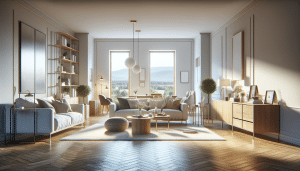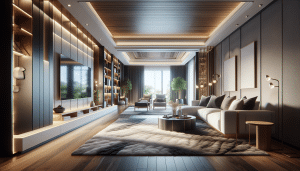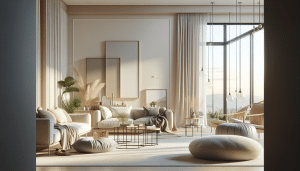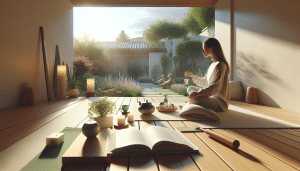Minimalist Living Hacks You Need to Transform Your Space
Jessica White September 28, 2025
Curious about crafting a calm, clutter-free home? Explore practical minimalist living hacks that help you simplify, organize, and transform every corner of your space—without sacrificing comfort or personality. Discover how intentional design and mindful habits unlock satisfaction, save time, and enhance your daily lifestyle.
Understanding the Minimalist Mindset in Home Life
Minimalism is much more than simply throwing things away. It represents a shift in how individuals relate to belongings, focusing on value and utility rather than accumulation. Many people are drawn to minimalist living because it emphasizes intentional choices and a calm environment. By curating possessions and embracing simplicity, homes become sanctuaries from external noise and stress. When everything in a space has a clear purpose, daily living becomes smoother and more satisfying. The minimalist mindset encourages individuals to think about what truly matters, often leading to a sense of freedom and mental clarity. Anyone seeking a fresh start or looking to minimize overwhelm can find inspiration in these principles of selective living.
One hallmark of the minimalist lifestyle is the idea of mindful consumption. This means considering each purchase carefully, asking whether it’s necessary and if it will contribute positively to one’s life. People who practice this frequently report feeling less pressure to buy new things, a benefit that supports both financial and environmental well-being. By focusing on multi-functional furniture, timeless decor, and high-quality everyday items, homes become easier to maintain and more pleasant to use. The mindset naturally extends to digital spaces as well, with many embracing digital decluttering to enhance productivity and reduce distractions, making technology work for them instead of the other way around.
Adopting minimalism isn’t about living with as little as possible—it’s about living with intention. There’s a growing movement exploring the intersection of minimalist living and personal style, proving that self-expression doesn’t require excess. Instead, intentionally chosen decorative objects or art can become focal points that reveal personality and spark joy. The minimalist mindset can be used as a guideline that adapts to any life stage, family size, or personal preference. Whether someone lives in a bustling city apartment or a quiet suburban home, minimalist living makes daily routines simpler and more enjoyable, supporting physical health and emotional well-being. (Source: https://www.ncbi.nlm.nih.gov/pmc/articles/PMC8875428/)
Decluttering Strategies to Create Tranquil Spaces
Effective decluttering begins with a plan. For many, the hardest part is knowing where to start, which is why experts recommend breaking projects into manageable chunks. Choose a small space such as a drawer, shelf, or corner and commit to organizing it. Sort items into categories: keep, donate, recycle, or discard. This process helps develop decluttering skills naturally, reinforcing the benefits as progress becomes visible. Over time, the habit becomes second nature, making maintenance simpler. When spaces are tidy, they naturally feel lighter and more centered, fostering a calming atmosphere. Even busy households can benefit from scheduled, regular decluttering sessions, making it easier to keep clutter under control long-term.
Developing routines is essential for keeping clutter at bay. Many people use specific decluttering rules, such as the one-in-one-out guideline, where a new item can only be brought in if something else is removed. Storage solutions play a big role too; baskets, wall-mounted organizers, multifunctional furniture, and under-bed storage can keep spaces orderly without adding visual noise. The visual impact of a decluttered space is profound, often changing the feel of the entire home. When clutter is minimized, cleaning becomes less burdensome and there’s more room for movement and creativity, which supports a higher quality of life and improved relaxation. (Source: https://www.health.harvard.edu/mind-and-mood/clearing-clutter-for-mental-health)
Consistent decluttering supports not only physical organization but mental clarity as well. Research suggests that cluttered environments increase cortisol levels, which is associated with stress. By making decluttering a recurring practice—perhaps each season or during holiday transitions—residents can reduce mental fatigue and keep their environment fresh. For families, involving children in the process can teach valuable organization and decision-making skills. Simple labels, categorized bins, and color-coded containers make tidying up easier for all ages. The process is as much about creating rituals as it is about results, inviting a sense of accomplishment and serenity that carries over into other aspects of daily living. (Source: https://www.apa.org/news/press/releases/2018/03/spring-cleaning)
Design Principles for Elegant Minimalist Interiors
Minimalist interior design is built on three pillars: simplicity, functionality, and harmony. Start by choosing a color palette with calming neutrals or soft hues to open up spaces and invite light. Avoid excessive patterns or overly vibrant colors, as these can be visually overwhelming. Instead, carefully select a few statement pieces—a unique lamp, a favorite artwork, or a designer chair—to shape the room’s personality. Open shelving and clean lines are typical in minimalist homes, making spaces feel larger and tidier. Well-planned layouts ensure each piece of furniture is essential and positioned for effortless traffic flow. (Source: https://www.houzz.com/magazine/decorating-guide-to-minimalist-living-stsetivw-vs~33216362)
Lighting is a powerful yet often overlooked aspect of minimalist design. Natural light is favored for its ability to soften interiors and elevate mood. Use light fabrics like linen or gauze for curtains and avoid heavy drapery that can make a space feel smaller. Mirrors can reflect daylight, brightening dark corners and making rooms seem more expansive. When artificial light is needed, opt for streamlined fixtures that contribute to the overall aesthetic without being distracting. The goal is always to enhance natural beauty, support clarity, and facilitate comfortable routines.
Materials also matter. Sustainable materials such as bamboo, reclaimed wood, or recycled metal add texture to a minimalist interior without cluttering the visual field. The tactile quality of textiles—think wool throws or jute rugs—creates comfort among clean lines. These touches turn sparse rooms into welcoming retreats. Designing with sustainability in mind benefits both the individual and the planet, creating a sense of alignment between values and everyday surroundings. Minimalist homes are personalized, functional, and, above all, pared back to the essentials that support intentional living. (Source: https://www.archdaily.com/922234/the-minimalist-approach-to-sustainable-design)
Maximizing Everyday Joy with Minimalist Habits
Minimalism is ultimately a pathway to greater daily enjoyment, not restriction. By reducing distractions, people often rediscover simple pleasures such as reading, cooking, or outdoor walks. Savoring these small routines can transform daily life, leading to greater appreciation and relaxation. Many minimalists cultivate habits such as regular gratitude journaling, mindfulness practices, or meal planning. These habits support clarity and purpose, reducing impulsivity and fostering contentment with what is already present. Incorporating moments of pause, deep breaths by a sunny window, or quiet time with a pet can boost mood and productivity alike.
Adopting minimalist habits can create space for creativity. With less mental and visual clutter, many people find themselves more inspired to pursue hobbies, start personal projects, or reconnect with old passions. Establishing clear boundaries between work and leisure, especially in a home setting, reinforces balance and prevents burnout. Small rituals—like a morning cup of coffee enjoyed in silence or a quick daily tidy—help anchor the day. Over time, these habits shape a lifestyle where satisfaction comes from experience and connection, not excess possessions. (Source: https://www.psychologytoday.com/us/blog/simple-sage/202208/less-stress-less-stuff)
Bringing minimalism into relationships can foster deeper connections. Instead of focusing on material gifts, try sharing experiences—like home-cooked meals or nature walks. Minimalist gatherings tend to emphasize conversation, shared memories, and meaningful interactions. These changes can have a ripple effect, encouraging friends and family to explore minimalist principles in their own lives and environments. The benefits grow over time, extending from the immediate household to social networks and community at large. Joy, it turns out, is often found in less—not more. (Source: https://greatergood.berkeley.edu/article/item/how_minimalism_can_maximize_your_happiness)
Overcoming Minimalism Misconceptions and Challenges
Despite its benefits, some myths persist about minimalist living. Minimalism is occasionally mischaracterized as boring, cold, or impractical—an image shaped by sparse social media photos rather than real homes. However, true minimalism is flexible and personal. Each person can define what minimalism means for their household, blending comfort, sentimentality, and function. The process isn’t about perfection or strictness but about reducing what overwhelms, allowing room for growth and expression. Open communication within households supports compromise when family members have different comfort levels with decluttering.
Challenges sometimes arise, especially in larger households or for people with sentimental attachments to objects. Strategies to address these include setting individual zones for personal belongings and celebrating small victories together. It’s also helpful to revisit motivations for embracing minimalism—whether they be environmental, financial, or emotional. When challenges are met with patience and flexibility, the minimalist journey becomes more sustainable and enjoyable. Individuals can adjust the pace, focusing on progress instead of perfection. (Source: https://news.harvard.edu/gazette/story/2019/03/the-pros-and-cons-of-minimalism/)
Minimalism can also feel difficult during major life transitions, such as moving or welcoming new family members. At these times, reframing the process as part of a new beginning helps reduce anxiety. Rather than seeing minimalist living as restrictive, view it as practical—an invitation to keep what truly adds meaning to life. Flexibility and adaptability remain essential, letting minimalism grow alongside new needs and stages. Each step in simplifying brings its own lessons, gradually revealing what is most important for happiness and wellbeing.
References
1. Gupta, S., & Singh, D. (2022). Minimalism and Mental Health: Exploring the Benefits of Simplified Living Spaces. Retrieved from https://www.ncbi.nlm.nih.gov/pmc/articles/PMC8875428/
2. Harvard Health Publishing. (n.d.). Clearing clutter for mental health. Retrieved from https://www.health.harvard.edu/mind-and-mood/clearing-clutter-for-mental-health
3. American Psychological Association. (2018). Spring cleaning for your mind. Retrieved from https://www.apa.org/news/press/releases/2018/03/spring-cleaning
4. Houzz. (n.d.). Decorating guide to minimalist living. Retrieved from https://www.houzz.com/magazine/decorating-guide-to-minimalist-living-stsetivw-vs~33216362
5. ArchDaily. (2019). The minimalist approach to sustainable design. Retrieved from https://www.archdaily.com/922234/the-minimalist-approach-to-sustainable-design
6. Greater Good Science Center. (n.d.). How minimalism can maximize your happiness. Retrieved from https://greatergood.berkeley.edu/article/item/how_minimalism_can_maximize_your_happiness








